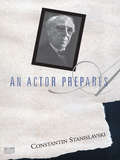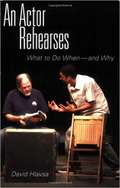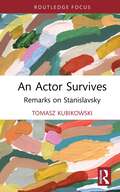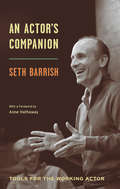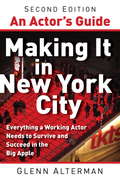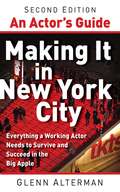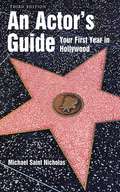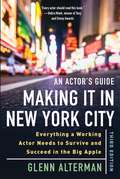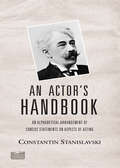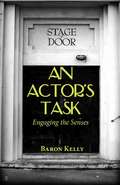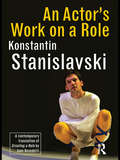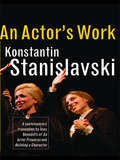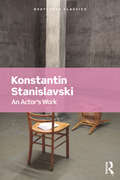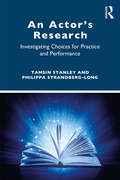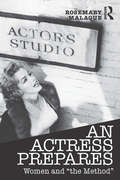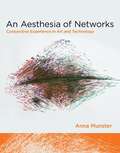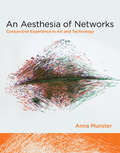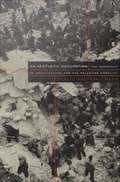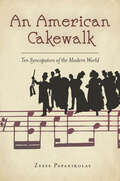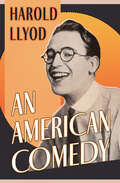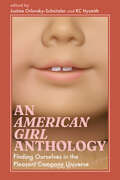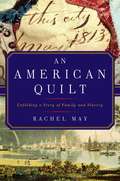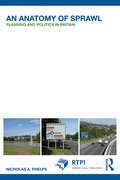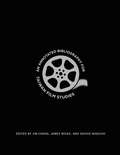- Table View
- List View
An Actor Prepares (Bloomsbury Revelations Ser.)
by Constantin StanislavskiStanislavski's simple exercises fire the imagination, and help readers not only discover their own conception of reality but how to reproduce it as well.
An Actor Rehearses: What to Do When and Why
by David HlavsaWith a commonsense approach, An Actor Rehearses takes performers through the rehearsal process and explains exactly what to do when. The actor’s process is explained simply, sequentially, and in detail, starting from the period before rehearsals begin and continuing through first read-through, blocking rehearsals, technical rehearsals, and performances. Packed with exercises that are useful in the classroom and in the rehearsal studio, An Actor Rehearses is an indispensable guide to the rehearsal process that makes building a character easier and more rewarding for both actor and audience. And because author David Hlavsa’s emphasis is on relating acting to life, performers learn to make a remarkable connection between becoming a better actor and becoming a better person: more compassionate, more vital, more alive. Clear, practical, usable advice for actors at every level Unique focus: learning to become a better actor means learning to become a better person Huge potential audienceAllworth Press, an imprint of Skyhorse Publishing, publishes a broad range of books on the visual and performing arts, with emphasis on the business of art. Our titles cover subjects such as graphic design, theater, branding, fine art, photography, interior design, writing, acting, film, how to start careers, business and legal forms, business practices, and more. While we don't aspire to publish a New York Times bestseller or a national bestseller, we are deeply committed to quality books that help creative professionals succeed and thrive. We often publish in areas overlooked by other publishers and welcome the author whose expertise can help our audience of readers.
An Actor Survives: Remarks on Stanislavsky (Routledge Advances in Theatre & Performance Studies)
by Tomasz KubikowskiThis book focuses on the analysis and interpretation of the first volume of the book An Actor’s Work by Konstantin Stanislavsky. This volume is the only part of his planned major work on theatre art that he was able to finish and authorise before his death. Its highly edited variant has long been known as ‘An Actor Prepares’ in the English-speaking world. Tomasz Kubikowski explores Stanislavsky’s material not only as a handbook of acting but also as a philosophical testament of Stanislavsky, in which he attempts to contain his most essential experiences and reflections. This book explores the underlying theme of ‘survival’ in its various meanings, from professional to existential; and the mechanisms and actions we attempt to survive. This study will be of great interest to students and scholars in theatre and performance studies.
An Actor's Companion
by Seth Barrish Anne Hathaway"I was totally unprepared for the transformation that Seth's technique created in me. . . . I realized that what I thought I knew about acting up to that point was largely misguided . . . but I now had a great, talented, dedicated teacher who generously wanted to share his tools with everyone. There is muscularity, not to mention wisdom and truth to Seth's techniques. He is a wonderful teacher, and I know that having him as my first guide is one of the luckiest things to have happened to me in my career and life. And when I can't get back to class with him, I am so grateful I have this book to turn to."--Anne Hathaway"This book is truly unlike anything else I know--these pieces are haikus on specific elements of performance and character building."--Philip Himberg, executive director, Sundance Theatre InstituteA collection of practical acting tips, tools, and exercises, An Actor's Companion is ideal for both the seasoned professionals and actors-in-training. The tips--all simple, direct, and useful--are easy to understand and even easier to apply, in both rehearsal and in performance.Seth Barrish is an actor, teacher, and the co-artistic director of The Barrow Group in New York City. In his thirty-year career, he has directed the award-winning shows My Girlfriend's Boyfriend (Lucille Lortel Award for Best Solo Show, Drama Desk and Outer Critics Circle nominations for Best Solo Show), Sleepwalk With Me (Nightlife Award for Outstanding Comedian in a Major Performance), The Tricky Part (Obie Award, Drama Desk nominations for Best Play and Best Solo Show), Pentecost (Drama Desk nomination for Best Play), Old Wicked Songs (Los Angeles Drama Critics Circle Award and Garland Award for Best Direction), and Good (Straw Hat Award for Best Direction), among dozens of others.
An Actor's Guide--Making It in New York City (Second Edition)
by Glenn AltermanFor any actor in or on the way to New York City, this is the definitive source for advice, winning strategies, marketing techniques, and invaluable insights to being a successful New York actor. This new edition has been completely revised and updatedto cover the significant changes in the New York theater landscape over the last nine years. This indispensable guide has also been expanded to include dozens of new interviews with top New York City actors and a completely improved Internet chapterequipped with the most up-to-date tools to thrive in the industry. Aspiring and established professionals will find this thorough and up-to-the-minute volume chock full of resources and advice about auditioning, making professional connections, promoting one's self, seeking opportunities in nontraditional venues, finding an apartment, securing "survival jobs," understanding actor unions, getting headshots, and furthering one's actor training in New York. This guide also details working as a film extra, careers in print modeling, scams and rip-offs to avoid, opportunities for actors with disabilities, and using the Internet to the fullest advantage. Included are in-depth interviews with legendary show business figures such as actor Henry Winkler, casting director Juliet Taylor, and theater director Joseph Chaikin as well as top talents from the fields of film, television, stage, commercials,and talent agencies. Written by a professional New York actor with over thirty years of experience, this meticulously researched guide will give actors the tools they need to survive and thrive in New York show business.
An Actor's Guide--Making It in New York City: Everything a Working Actor Needs to Survive and Succeed in the Big Apple
by Glenn AltermanFor any actor in or on the way to New York City, this is the definitive source for advice, winning strategies, marketing techniques, and invaluable insights to being a successful New York actor. This new edition has been completely revised and updated to cover the significant changes in the New York theater landscape over the last nine years. This indispensable guide has also been expanded to include dozens of new interviews with top New York City actors and a completely improved Internet chapter equipped with the most up-to-date tools to thrive in the industry. Aspiring and established professionals will find this thorough and up-to-the-minute volume chock full of resources and advice about auditioning, making professional connections, promoting one's self, seeking opportunities in nontraditional venues, finding an apartment, securing "survival jobs," understanding actor unions, getting headshots, and furthering one's actor training in New York. This guide also details working as a film extra, careers in print modeling, scams and rip-offs to avoid, opportunities for actors with disabilities, and using the Internet to the fullest advantage. Included are in-depth interviews with legendary show business figures such as actor Henry Winkler, casting director Juliet Taylor, and theater director Joseph Chaikin as well as top talents from the fields of film, television, stage, commercials, and talent agencies. Written by a professional New York actor with over thirty years of experience, this meticulously researched guide will give actors the tools they need to survive and thrive in New York show business.
An Actor's Guide--Your First Year in Hollywood: Your First Year In Hollywood
by Michael St. NicolasAn Actor's Guide-Your First Year in Hollywood should be required reading for any young actor headed to La-La Land with a dream in his heart and a shine on his shoes. Sure, it's a great guide to auditioning, getting a SAG card, finding an agent, landing parts, gaining exposure, and creating publicity-but it's also packed with real-world advice from a fellow actor. Getting to know Los Angeles, finding a place to live and a job to pay the bills. An Actor's Guide presents the whole picture, for career and for daily life. Remember to thank us when you're a big star!
An Actor's Guide—Making It in New York City, Third Edition: Everything a Working Actor Needs to Survive and Succeed in the Big Apple
by Glenn AltermanA Step-by-Step Guide for the Actor Pursuing a Career in New York A great deal has changed in the industry in the last decade. In this new, third edition of An Actor&’s Guide—Making It in New York City, Glenn Alterman provides everything actors need to know. You&’ll discover the ten things that it takes to make it as a successful actor in the city, how to support yourself, where and how to start your life as a New York actor, understanding and marketing &“your brand,&” the best acting schools and conservatories, effective ways to contact agents and casting directors, and more. The author, a successful working actor, also shares many insider tips on topics such as: how to network effectivelyheadshots, photographers, and how to have a successful photo sessioncreating your actor websitesthe best Internet resources and casting siteshow to give winning auditions and interviewsfinding and developing great monologuesoff and off-off Broadway opportunitiesTV and film opportunitiesvoice-overscommercial print modelingcommercialssurvival jobsappropriate behavior in the businessscams and rip-offs to avoidinformation for actors with disabilitiesinformation on diversity and LGBTQ concernsa listing of agents, casting directors and theaters Among the book&’s many interviews are legendary show business figures, such as actors Henry Winkler, Alison Fraser, Dylan Baker, Lisa Emery, and Charles Busch, as well as casting directors Juliet Taylor, Ellen Lewis, Jay Binder, Donna DeSeta, and Liz Lewis, among many others. With Alterman&’s essential guide, you&’ll be prepared to launch and maintain your dream career in the city that never sleeps.
An Actor's Handbook: An Alphabetical Arrangement of Concise Statements on Aspects of Acting, Reissue of first edition
by Elizabeth Reynolds Hapgood Constantin StanislavskiThis is the classic lexicon of Stanislavski's most important concepts, all in the master's own words. Upon its publication in 1963, An Actor's Handbook quickly established itself as an essential guide for actors and directors. Culling key passages from Stanislavski's vast output, this book covers more than one hundred and fifty key concepts, among them 'Improvisation', 'External Technique', 'Magic If', 'Imaginary Objects', 'Discipline', 'What Is My System?' and 'Stage Fright'.This reissued, attractively packaged edition will be an essential book for any performer.
An Actor's Task: Engaging the Senses
by Baron KellyAn Actor's Task provides a framework for studying the dual arts of acting: inhabiting a character both physically and psychologically. Actors at all levels can use this book to explore, develop, and review the sensory tools and training that enable them to be the best versions of themselves and, ultimately, to bring that understanding of "self" to their art. Innovative new exercises and selected classics--updated for today's students--comprise more than 100 exercises. Introductions to each exercise explain its aims and benefits. Clear step-by-step prompts provide guidance. Debriefing sections engage actors in reflection on what they have experienced and learned. This inspired text is equally suited to classroom use and individual study.
An Actor's Work on a Role
by Konstantin StanislavskiAn Actor’s Work on a Role is Konstantin Stanislavski’s exploration of the rehearsal process, applying the techniques of his seminal actor training system to the task of bringing truth to one’s chosen role. Originally published over half a century ago as Creating a Role, this book was the third in a planned trilogy – after An Actor Prepares and Building a Character, now combined in An Actor’s Work – in which Stanislavski sets out his psychological, physical and practical vision of actor training. This new translation from renowned scholar Jean Benedetti not only includes Stanislavski’s original teachings, but is also furnished with invaluable supplementary material in the shape of transcripts and notes from the rehearsals themselves, reconfirming 'The System' as the cornerstone of actor training.
An Actor's Work: A Student's Diary
by Konstantin StanislavskiStanislavski’s ‘system’ has dominated actor-training in the West since his writings were first translated into English in the 1920s and 30s. His systematic attempt to outline a psycho-physical technique for acting single-handedly revolutionized standards of acting in the theatre. Until now, readers and students have had to contend with inaccurate, misleading and difficult-to-read English-language versions. Some of the mistranslations have resulted in profound distortions in the way his system has been interpreted and taught. At last, Jean Benedetti has succeeded in translating Stanislavski’s huge manual into a lively, fascinating and accurate text in English. He has remained faithful to the author's original intentions, putting the two books previously known as An Actor Prepares and Building A Character back together into one volume, and in a colloquial and readable style for today's actors. The result is a major contribution to the theatre, and a service to one of the great innovators of the twentieth century.
An Actor's Work: A Student's Diary (Routledge Classics)
by Konstantin StanislavskiStanislavski’s ‘system’ has dominated actor-training in the West since his writings were first translated into English in the 1920s and 30s. His systematic attempt to outline a psycho-physical technique for acting single-handedly revolutionized standards of acting in the theatre. Until now, readers and students have had to contend with inaccurate, misleading and difficult-to-read English-language versions. Some of the mistranslations have resulted in profound distortions in the way his system has been interpreted and taught. At last, Jean Benedetti has succeeded in translating Stanislavski’s huge manual into a lively, fascinating and accurate text in English. He has remained faithful to the author's original intentions, putting the two books previously known as An Actor Prepares and Building A Character back together into one volume, and in a colloquial and readable style for today's actors. The result is a major contribution to the theatre, and a service to one of the great innovators of the twentieth century. This Routledge Classics edition includes a new Foreword by the director Richard Eyre.
An Actor’s Research: Investigating Choices for Practice and Performance
by Tamsin Stanley Philippa Strandberg-LongAn Actor’s Research: Investigating Choices for Practice and Performance presents an accessible and highly practical guide to the research approaches required of the actor. It aims to establish the precision and rigour of the actor’s craft that is intrinsic to a compelling acting performance, explore a range of research activities surrounding and emerging from practical work in the studio, and enable the actor to evolve a multifaceted skillset in researching for performance. The chapters focus on different research areas such as the self, character, relationships, circumstance, and context, providing accessible and practical guidance to developing a personal research practice. Each aspect is explained and engaged with as practice, rather than study – offering helpful hints and advising against common pitfalls – ultimately enabling the actor to locate the necessary knowledge to shape and inform their performance in both text-based and devised scenarios. Additionally, as the actor’s self is a personal instrument that is drawn on in terms of expression, impulses, and imagination; the self also becomes a source for creative appraisal and research. This book therefore offers comprehensive advice and strategies for self-evaluation and reflection, connecting research investigation with self-exploration in making expressive performance choices, making it a practice highly applicable to the actor’s needs. An Actor’s Research closely follows the training actor’s needs in terms of performance-based research; however, its practical research activities for text and character creation and strategies for the development of critical thinking and self-reflective skills support the ongoing development of the actor and their craft in both training and professional circumstances.
An Actress Prepares: Women and "the Method"
by Rosemary Malague'Every day, thousands of women enter acting classes where most of them will receive some variation on the Stanislavsky-based training that has now been taught in the U.S. for nearly ninety years. Yet relatively little feminist consideration has been given to the experience of the student actress: What happens to women in Method actor training?' An Actress Prepares is the first book to interrogate Method acting from a specifically feminist perspective. Rose Malague addresses "the Method" not only with much-needed critical distance, but also the crucial insider's view of a trained actor. Case studies examine the preeminent American teachers who popularized and transformed elements of Stanislavsky’s System within the U.S.—Strasberg, Adler, Meisner, and Hagen— by analyzing and comparing their related but distinctly different approaches. This book confronts the sexism that still exists in actor training and exposes the gender biases embedded within the Method itself. Its in-depth examination of these Stanislavskian techniques seeks to reclaim Method acting from its patriarchal practices and to empower women who act. 'I've been waiting for someone to write this book for years: a thorough-going analysis and reconsideration of American approaches to Stanislavsky from a feminist perspective ... lively, intelligent, and engaging.' – Phillip Zarrilli, University of Exeter 'Theatre people of any gender will be transformed by Rose Malague’s eye-opening study An Actress Prepares... This book will be useful to all scholars and practitioners determined to make gender equity central to how they hone their craft and their thinking.' – Jill Dolan, Princeton University
An Aesthesia of Networks
by Anna MunsterToday almost every aspect of life for which data exists can be rendered as a network. Financial data, social networks, biological ecologies: all are visualized in links and nodes, linesconnecting dots. A network visualization of a corporate infrastructure could look remarkably similarto that of a terrorist organization. In An Aesthesia of Networks, Anna Munsterargues that this uniformity has flattened our experience of networks as active and relationalprocesses and assemblages. She counters the "network anaesthesia" that results from thispervasive mimesis by reinserting the question of experience, or aesthesia, into networked cultureand aesthetics. Rather than asking how humans experience computers and networks, Munster asks hownetworks experience -- what operations they perform and undergo to change andproduce new forms of experience. Drawing on William James's radical empiricism, she asserts thatnetworked experience is assembled first and foremost through relations, which make up its mostimmediately sensed and perceived aspect. Munster critically considers a range of contemporaryartistic and cultural practices that engage with network technologies and techniques, includingdatabases and data mining, the domination of search in online activity, and the proliferation ofviral media through YouTube. These practices -- from artists who "undermine" data tomusicians and VJs who use intranetworked audio and video software environments -- are concerned withthe relationality at the core of today's network experience.
An Aesthesia of Networks: Conjunctive Experience in Art and Technology (Technologies of Lived Abstraction)
by Anna MunsterThe experience of networks as the immediate sensing of relations between humans and nonhuman technical elements in assemblages such as viral media and databases.Today almost every aspect of life for which data exists can be rendered as a network. Financial data, social networks, biological ecologies: all are visualized in links and nodes, lines connecting dots. A network visualization of a corporate infrastructure could look remarkably similar to that of a terrorist organization. In An Aesthesia of Networks, Anna Munster argues that this uniformity has flattened our experience of networks as active and relational processes and assemblages. She counters the “network anaesthesia” that results from this pervasive mimesis by reinserting the question of experience, or aesthesia, into networked culture and aesthetics.Rather than asking how humans experience computers and networks, Munster asks how networks experience—what operations they perform and undergo to change and produce new forms of experience. Drawing on William James's radical empiricism, she asserts that networked experience is assembled first and foremost through relations, which make up its most immediately sensed and perceived aspect. Munster critically considers a range of contemporary artistic and cultural practices that engage with network technologies and techniques, including databases and data mining, the domination of search in online activity, and the proliferation of viral media through YouTube. These practices—from artists who “undermine” data to musicians and VJs who use intranetworked audio and video software environments—are concerned with the relationality at the core of today's network experience.
An Aesthetic Occupation
by Daniel Bertrand MonkIn An Aesthetic Occupation Daniel Bertrand Monk unearths the history of the unquestioned political immediacy of "sacred" architecture in the conflict between Palestinians and Israelis. Monk combines groundbreaking archival research with theoretical insights to examine in particular the Mandate era--the period in the first half of the twentieth century when Britain held sovereignty over Palestine. While examining the relation between monuments and mass violence in this context, he documents Palestinian, Zionist, and British attempts to advance competing arguments concerning architecture's utility to politics. Succumbing neither to the view that monuments are autonomous figures onto which political meaning has been projected, nor to the obverse claim that in Jerusalem shrines are immediate manifestations of the political, Monk traces the reciprocal history of both these positions as well as describes how opponents in the conflict debated and theorized their own participation in its self-representation. Analyzing controversies over the authenticity of holy sites, the restorations of the Dome of the Rock, and the discourse of accusation following the Buraq, or Wailing Wall, riots of 1929, Monk discloses for the first time that, as combatants looked to architecture and invoked the transparency of their own historical situation, they simultaneously advanced--and normalized--the conflict's inability to account for itself. This balanced and unique study will appeal to anyone interested in Israel or Zionism, the Palestinians, the Middle East conflict, Jerusalem, or its monuments. Scholars of architecture, political theory, and religion, as well as cultural and critical studies will also be informed by its arguments.
An American Cakewalk: Ten Syncopators of the Modern World
by Zeese PapanikolasThe profound economic and social changes in the post-Civil War United States created new challenges to a nation founded on Enlightenment and transcendental values, religious certainties, and rural traditions. Newly-freed African Americans, emboldened women, intellectuals and artists,and a polyglot tide of immigrants found themselves in a restless new world of railroads, factories, and skyscrapers where old assumptions were being challengedand new values had yet to be created. InAn American Cakewalk: Ten Syncopators of the Modern World, Zeese Papanikolas tells the lively and entertaining story of a diverse group of figures in the arts and sciences who inhabited this new America. Just as ragtime composers subverted musical expectations by combining European march timing with African syncopations, so this book's protagonists--who range from Emily Dickinson toThorstein Veblen and from Henry and William James to Charles Mingus--interrogated the modern American world through their own "syncopations" of cultural givens. The old antebellum slave dance, the cakewalk, with its parody of the manners and pretensions of the white folks in the Big House, provides a template of how the tricksters, shamans, poets, philosophers, ragtime pianists, and jazz musicians who inhabit this book used the arts of parody, satire, and disguise to subvert American cultural norms and to create new works of astonishing beauty and intellectual vigor.
An American Comedy
by Harold Lloyd Wesley W. StoutThis autobiography by an influential silent film star gives an insider&’s view of the motion picture industry in the early twentieth century. It&’s one of the most enduring images in film history: a young man in circular glasses, dangling from the hands of a clock high above Los Angeles. The actor performing this daring stunt was Harold Lloyd, a highly successful comedian from the silent film era. Lloyd made nearly two hundred comedies, both silent and &“talkies,&” between 1914 and 1947. He is best known for his &“Glass&” character, a bespectacled everyman who captured the mood of the 1920s. In this fascinating autobiography, which was written just around the time sound was revolutionizing cinema, Lloyd chronicles his experiences as a performer and producer of silent films, preserving firsthand details of Hollywood&’s bygone period. This extraordinary memoir, originally published in 1928, discusses actors both comedic and dramatic, stage to film adaptations, producers, directors, and primarily, how early silent movies were made. It is a must-read for film historians and movie buffs alike.
An American Girl Anthology: Finding Ourselves in the Pleasant Company Universe (Cultures of Childhood)
by Kc Hysmith Justine Orlovsky-SchnitzlerContributions by Mary Berman, Mary M. Burke, Abigail C. Fine, Juliette Holder, KC Hysmith, Mackenzie Kwok, Esther Martin, Hannah Matthews, Janine B. Napierkowski, Justine Orlovsky-Schnitzler, Samantha Pickette, Sheena Roetman-Wynn, Rebekkah Rubin, Marissa J. Spear, Tara Strauch, Cary Tide, and Laura TraisterAn American Girl Anthology: Finding Ourselves in the Pleasant Company Universe turns American Girl dolls—and the ever-growing ecosystem surrounding them—inside out. Editors Justine Orlovsky-Schnitzler and KC Hysmith, along with an expansive list of contributors across multiple disciplines and within different research areas, explore Pleasant Company (American Girl’s parent corporation) and the social and cultural impact the dolls and broader American Girl universe continue to have for generations of American consumers through thoughtful and fun essays. This collection serves as an ode to the democratizing power of the internet and the intoxicating power of nostalgia, while also looking toward the future as the eldest American Girl fans become parents themselves. It is also a critical account of the ways in which American Girl has shaped senses of self-worth and hopes for the future, securing a base of lifelong consumers, and also serves as a love letter to the kids we collectively used to be. Along the way, readers will take seriously American Girl’s influence and place within larger cultural conversations. They will find essays focusing on topics as diverse as food and historical recipes in American Girl publications, the advent of “tag yourself” memes, the struggle to find authentic and long-lasting Asian American representation within the pages of the American Girl catalog, and the enduring power of The Care and Keeping of You as a resource for finding joy in our bodies.
An American Health Dilemma: Race, Medicine, and Health Care in the United States 1900-2000
by W. Michael Byrd Linda A. ClaytonFirst published in 2002. An American Health Dilemma is the story of medicine in the United States from the perspective of people who were consistently, officially mistreated, abused, or neglected by the Western medical tradition and the US health-care system. It is also the compelling story of African Americans fighting to participate fully in the health-care professions in the face of racism and the increased power of health corporations and HMOs. This tour-de-force of research on the relationship between race, medicine, and health care in the United States is an extraordinary achievement by two of the leading lights in the field of public health. Ten years out, it is finally updated, with a new third volume taking the story up to the present and beyond, remaining the premiere and only reference on black public health and the history of African American medicine on the market today. No one who is concerned with American race relations, with access to and quality of health care, or with justice and equality for humankind can afford to miss this powerful resource.
An American Quilt: Unfolding A Story Of Family And Slavery
by Rachel MayFollowing the trail left by an unfinished quilt, this illuminating saga examines slavery from the cotton fields of the South to the textile mills of New England—and the humanity behind it. When we think of slavery, most of us think of the American South. We think of back-breaking fieldwork on plantations. We don’t think of slavery in the North, nor do we think of the grueling labor of urban and domestic slaves. Rachel May’s rich new book explores the far reach of slavery, from New England to the Caribbean, the role it played in the growth of mercantile America, and the bonds between the agrarian south and the industrial north in the antebellum era—all through the discovery of a remarkable quilt. While studying objects in a textile collection, May opened a veritable treasure-trove: a carefully folded, unfinished quilt made of 1830s-era fabrics, its backing containing fragile, aged papers with the dates 1798, 1808, and 1813, the words “shuger,” “rum,” “casks,” and “West Indies,” repeated over and over, along with “friendship,” “kindness,” “government,” and “incident.” The quilt top sent her on a journey to piece together the story of Minerva, Eliza, Jane, and Juba—the enslaved women behind the quilt—and their owner, Susan Crouch. May brilliantly stitches together the often-silenced legacy of slavery by revealing the lives of these urban enslaved women and their world. Beautifully written and richly imagined, An American Quilt is a luminous historical examination and an appreciation of a craft that provides such a tactile connection to the past.
An Anatomy of Sprawl: Planning and Politics in Britain (RTPI Library Series)
by Nicholas A. PhelpsDespite the combined efforts of British planners, politicians, the public and interest groups, the ‘Solent City’ stands as one of a number of instances of a peculiar instance of urban sprawl – muted, and slow to emerge – yet produced paradoxically by very strong interests in promoting conservation and restraint. This unique and valuable case study, while focusing on the planning and development of South Hampshire in particular, enables an in-depth study of the issues surrounding planning strategies with regards to growing populations.
An Annotated Bibliography for Taiwan Film Studies
by James Jim Cheng Wicks Noguchi SachieCompiled by two skilled librarians and a Taiwanese film and culture specialist, this volume is the first multilingual and most comprehensive bibliography of Taiwanese film scholarship, designed to satisfy the broad interests of the modern researcher. The second book in a remarkable three-volume research project, An Annotated Bibliography for Taiwan Film Studies catalogues the published and unpublished monographs, theses, manuscripts, and conference proceedings of Taiwanese film scholars from the 1950s to 2013. Paired with An Annotated Bibliography for Chinese Film Studies (2004), which accounts for texts dating back to the 1920s, this series brings together like no other reference the disparate voices of Chinese film scholarship, charting its unique intellectual arc. <P><P>Organized intuitively, the volume begins with reference materials (bibliographies, cinematographies, directories, indexes, dictionaries, and handbooks) and then moves through film history (the colonial period, Taiwan dialect film, new Taiwan cinema, the 2/28 incident); film genres (animated, anticommunist, documentary, ethnographic, martial arts, teen); film reviews; film theory and technique; interdisciplinary studies (Taiwan and mainland China, Taiwan and Japan, film and aboriginal peoples, film and literature, film and nationality); biographical materials; film stories, screenplays, and scripts; film technology; and miscellaneous aspects of Taiwanese film scholarship (artifacts, acts of censorship, copyright law, distribution channels, film festivals, and industry practice). Works written in multiple languages include transliteration/romanized and original script entries, which follow universal AACR-2 and American cataloguing standards, and professional notations by the editors to aid in the use of sources.
